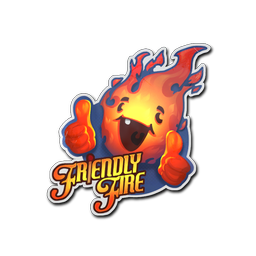Beauty Reports: Trends & Tips
Stay updated with the latest in beauty trends, tips, and product reviews.
Friendly Fire: A CS2 Player's Greatest Ally or Worst Enemy?
Is friendly fire your ally or enemy in CS2? Discover the surprising impact it has on gameplay and team dynamics in our latest blog post!
Understanding Friendly Fire in CS2: Risks and Strategies
Understanding Friendly Fire in CS2 is crucial for players seeking to improve their gameplay and team dynamics. Friendly fire occurs when a player unintentionally damages or kills a teammate, which can result in significant consequences during a match. The risks associated with friendly fire can lead to decreased team morale, wasted resources, and ultimately, a loss of the game. It's essential for players to communicate effectively, establish clear roles, and maintain situational awareness to minimize the chances of inadvertently harming their allies.
To mitigate the risks of friendly fire in CS2, teams can implement several strategies. First, players should make use of voice chat or in-game communication tools to announce their actions, especially when engaging in aggressive moves or utilizing explosive ordnance. Second, consider employing a strategy that emphasizes spacing and positioning during engagements with the enemy. By maintaining a safe distance from teammates, players can greatly reduce the likelihood of accidental shootings. Lastly, practicing teamwork through regularly scheduled scrimmages can foster better coordination and understanding among players, ultimately reducing the incidents of friendly fire.

Counter-Strike is a popular series of multiplayer first-person shooter games that focus on team-based gameplay. Players can earn various in-game items and skins, including the Silver Case, which adds a unique flair to their weapons as they compete against opponents around the world.
The Impact of Friendly Fire on Team Dynamics
The impact of friendly fire on team dynamics can be profound and multifaceted. When team members inadvertently harm each other, it can lead to a breakdown of trust and collaboration. This phenomenon often creates tension, as individuals may become hesitant to engage fully for fear of making mistakes. Moreover, the repercussions of friendly fire extend beyond immediate conflict, potentially resulting in long-lasting emotional scars that affect team morale. Establishing clear communication and protocols can help mitigate these risks, yet the psychological ramifications can still linger.
Furthermore, dealing with the aftermath of friendly fire involves a delicate balancing act. Teams must address the incident openly to rebuild trust, while also ensuring that blame is not disproportionately placed on any one individual. Implementing regular team-building activities and encouraging open dialogue about mistakes can foster a culture of accountability and resilience. By learning from these incidents, teams can emerge stronger and more cohesive, turning potential setbacks into opportunities for growth and enhanced collaboration.
Is Friendly Fire a Necessary Evil in Competitive CS2?
The debate over whether friendly fire in competitive CS2 is a necessary evil is one that evokes strong opinions among players and analysts alike. On one hand, friendly fire can lead to tense and exciting gameplay, where each decision carries weight, and teammates must communicate effectively to avoid accidents. This mechanic adds a layer of strategy and realism; for example, players must consider their positioning and aim carefully, especially in high-stakes situations. The potential for accidents encourages players to develop their situational awareness, which can ultimately elevate the overall skill level of the match.
However, the downsides of friendly fire cannot be overlooked. In a highly competitive environment, mistakes caused by accidental team damage can lead to significant disadvantages, resulting in the loss of critical rounds or matches. Frustration can mount when players feel they are being penalized for minor errors, leading to a negative gaming experience. Therefore, while friendly fire can enhance competitiveness and require heightened communication, its impact on team dynamics and performance raises the question: Is it truly worth the risk in an already challenging environment?